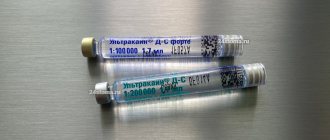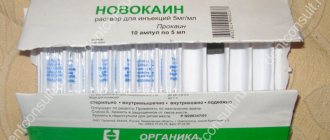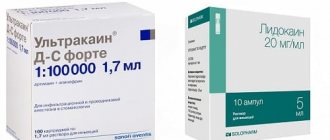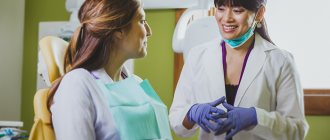In women, after the birth of a child, the condition of their teeth deteriorates greatly. This is due to the fact that during gestation the mother transferred most of the calcium to the baby, and after birth she continues to give away the valuable mineral through breast milk. As a result, the mother's teeth are destroyed. In this case, you need to go to the hospital, where painkillers are often used during procedures.
Ultracaine is a modern anesthetic that is often used in dentistry. The drug acts locally and exhibits a therapeutic effect 1.5 - 3 minutes after administration of a small dose. The anesthetic effect lasts for 1 to 5 hours. Nursing mothers are wondering whether they can use the medication for dental treatment. According to doctors, this is a safe drug for lactation.
Device structure
The electrophoresis apparatus is an alternating current rectifier, semiconductor (now), electron tube (formerly). It operates from a standard network with a frequency of 50 Hz and a voltage of 220 V and is equipped with a milliammeter.
Electrophoresis devices operate primarily using galvanic current. It is continuous, low voltage, constant intensity. Always passing in one direction, the current is able to maintain polarity, strength, and voltage. The action is comparable to a blow of wind that does not change its strength. Thanks to this, the electrophoresis device is able to “deliver” drugs deep into the body, affecting the tissues and mucous membranes of the body. For direct current, even dense tissues can be considered permeable.
Mechanism of action of electrophoresis
Electrophoresis introduces drugs percutaneously directly into the pathological focus. The device promotes the breakdown of substances into smaller particles - ions. They move towards the electrophoresis electrodes from opposite poles. When approaching them, the ions undergo electrolysis. They change from ions to atoms due to the loss of their charge.
If a drug is placed on one of the electrodes, it begins to move into the tissue. There it accumulates in depth in the form of a depot and is slowly consumed (up to 2 weeks). Knowing the specific density and resistance of body tissues, the physicochemical properties of the drug, and the parameters of the electric current, it is possible to accurately determine the concentration of the drug at a given depth.
There are two types of ions: anions (-), cations (+). Water breaks down into H (+) and OH (-). Near the electrodes, ions interact with water and form acid and alkali. Therefore, burns are likely at the site where the cathode and anode are attached, and during electrophoresis, pads moistened with water are always used to dilute these solutions.
A change in ion concentration causes the body's cells to become excited. Metabolic processes and the ability to respond to external influences are accelerated. Ultimately, this accelerates intracellular recovery and removes metabolic products faster.
Will electrophoresis help get rid of a hernia?
Galvanization is prescribed for hernias as an auxiliary or primary method of treatment. It is not able to get rid of advanced forms of the disease. Its main action is aimed at stimulating the natural regenerative abilities of tissues and relieving pain in the initial stages of the disease.
The use of electrophoresis for hernia leads to:
- changes in the permeability of cell membranes - cells become more sensitive, regenerative capacity increases;
- dilation of blood vessels, which promotes blood flow and the supply of more essential nutrients;
- increased lymphatic drainage - decomposition products are removed more quickly;
- the occurrence of local and general reflex reactions.
Thanks to this, the affected tissues are restored faster, the foci of inflammation are reduced, and the pain syndrome is weakened.
After treatment, most patients experience a decrease in the volume of the hernia by 50% or more, its structure becomes more homogeneous and less dense. In the case of small hernias, in some patients their complete disappearance was recorded.
Is it possible to treat teeth while breastfeeding?
Lactation is not a reason to avoid going to the dentist. A nursing mother should visit the dentist more often than usual. But before the doctor begins treatment, you need to inform him about breastfeeding so that he can select the right pain reliever. Anesthesia during breastfeeding should be gentle and quickly eliminated from the body. Then she does not pose any threat to the baby.
There is no danger when taking an x-ray. Its rays do not have any harmful effect on milk. These statements are erroneous. A lead apron will help protect your chest and stomach.
Dental treatment during lactation is possible, but not all procedures are permitted. The standard procedure for eliminating caries has no contraindications. But installing braces or implantation will have to wait.
Advantages of using electrophoresis
The main advantage is the rapid achievement of a positive effect due to local effects. Medicines are administered specifically to the desired site. This compares favorably with this method of treatment even from injections. Electrophoresis allows it to be used even by patients with diseases of the liver, kidneys, and gastrointestinal tract (there is no load on these organs). It can be used by people with blood flow disorders. In this case, standard tablets and injections will be ineffective. And the action of galvanic current bypasses the circulatory system.
Already after the first session of electrophoresis, the pain syndrome associated with a hernia decreases
Electrophoresis is effective due to the long-lasting current. Therefore, it is carried out in a course, with pre-calculated sessions. During the intervals between them, the therapeutic effect is maintained.
Electrophoresis has no side effects. The process is non-invasive, so there is no discomfort or recovery period. The action of current through tissue does not cause allergic reactions, eliminating the possibility of overdose.
Application of anesthetic
A large number of modern dental clinics use Ultracain for pain relief. This is due to the fact that this drug is more effective than classical anesthetics (Lidocaine, Novocaine). In addition, the drug is safe and practically does not cause negative effects.
The dose of the medication depends on the depth and duration of the procedure. The dentist determines the required dose of medication for each patient separately. However, when making a decision, the doctor is guided by the following rules regarding the dose of the drug:
- To remove 1 or several teeth located nearby, 1.7 ml of solution is injected. To remove several teeth located far away, 2 injections (1.7 ml each) are given near each one. If after administration of the solution the therapeutic effect does not appear, then the same dose is administered, but into one tooth. In the absence of anesthesia, Ultracaine is abandoned and a complete blockade is carried out.
- When grinding teeth, 1 ml of solution is injected under the crown near the damaged tooth.
- When cutting or suturing the palate, 0.1 ml of the drug is injected near the damaged area.
Adults are prohibited from administering more than 7 mg/1 kg of the drug during treatment procedures. The normal dosage of the drug, which is well tolerated by patients, is about 12.5 ml. The child is prohibited from administering more than 5 mg/1 kg. Ultracaine is approved for use in children over 4 years of age.
Indications for procedures
Electrophoresis is prescribed to all patients diagnosed with a hernia who experience severe pain - an inevitable companion to this disease. Other indications depend on the type of protrusion.
Each type of intervertebral hernia has serious complications, so you should not delay treatment.
See how easy it is to get rid of a hernia in 10 sessions
Indications for electrophoresis for cervical hernia
For herniated intervertebral discs in the cervical spine, electrophoresis is prescribed for:
- dizziness and migraines;
- surges in blood pressure;
- weakness in the upper limbs;
- loss of sensitivity in the limbs;
- limitation of movement, muscle weakness.
Read more about cervical hernia in this article.
Indications for electrophoresis for thoracic hernia
For a thoracic hernia, electrophoresis is indicated for anyone who has:
- numbness, tingling in the upper extremities;
- limited mobility due to muscle hypertonicity.
Read more about the symptoms and treatment of thoracic intervertebral hernia here.
Indications for electrophoresis for lumbar hernia
For a lumbar hernia, electrophoresis is prescribed if the following symptoms are present:
- tingling sensation, numbness of the lower extremities;
- problems with urination;
- the feeling that “your legs won’t obey you.”
Read about other symptoms in the article “Intervertebral hernia of the lumbar spine.”
How an electrophoresis session is performed in the clinic
Electrophoresis sessions are carried out in a special physiotherapy room.
What devices are used
The most popular device for carrying out the procedure is Potok-1. It has long proven itself in the market and does not lose its effectiveness and demand. This is what is used in most clinics.
But there are a large number of modern devices:
- Elfor;
- Nevoton;
- Mustang-Physio-GalvaFor et al.
Electrophoresis devices
The differences between them are minimal. All are easy to use, they have a compact shape and are affordable. The operation of any device is based on galvanic current, which flows continuously, with constant intensity, in one direction. But sometimes Trabert current is used. It has higher frequency, amplitude modulated currents that do not move in a straight line. They can pass sinusoidally, pulsate or change randomly.
Devices can also be equipped with:
- sinusoidal modulated currents;
- pulsed diadynamic currents (DDT);
- fluctuating current.
What types of intervertebral hernias are most difficult to treat?
4 stages of treatment for intervertebral hernia
Procedure
Before the procedure, the specialist prepares the apparatus and solution. You need to adjust the required current strength, which is selected by the attending physician. Electrodes are then attached to the patient with wipes moistened with a special liquid consisting of prescribed medications and water.
Gaskets are installed based on the location of pathological foci. They need to be attached as close to their center as possible. Due to this, the maximum positive effect is obtained.
Electrode location:
- For a cervical hernia,
the first electrode (+) is attached to the neck, the other (-) to the lumbar area. - In case of pathology of the thoracic discs
- (+) is attached to the thoracic spine, (-) to the lower back. - For a lumbar hernia
, the method of split electrodes is used: (+) attached to the lower back, split (two electrodes) (-) attached to the legs - in the back of the thighs or calves.
Then turn on the device and slowly increase the current based on the recommendations. This eliminates discomfort for the patient. During the first session, the electrodes are left on for only 10-15 minutes in order to observe the patient’s condition and completely eliminate negative consequences.
What should the current be?
The current strength for all types of hernias is on average the same. The device is set at 6 milliamps and gradually increased to 15. But these values may vary depending on the characteristics of the human body and the stage of the disease.
Session duration
The duration of the session for cervical hernias is from 5 to 15 minutes. When treating the thoracic and lumbar areas, the procedure will take an average of 20 minutes.
What should be the duration of the course?
The course for cervical hernias is 15 sessions, for pathologies of the thoracic and lumbar spine - 20. These are average numbers, the exact number is determined by a specialist, based on the needs and characteristics of the body. Procedures can be done daily or every other day. The main thing is to complete the entire course in order to achieve a positive effect.
How does the patient feel?
During the procedure, the patient may experience a slight tingling or warmth under the electrodes. Under no circumstances should there be pain or burning sensation. If they occur, the procedure is completed immediately.
The electrophoresis procedure is painless
Cost of electrophoresis
The cost of electrophoresis treatment consists of the cost of medications and the procedure. The average price of medicines is 70 rubles, and procedures – from 500 rubles.
Ultracaine for breastfeeding
According to doctors, Ultracain is allowed to be used during breastfeeding. This is due to the fact that modern anesthetic is completely eliminated from the body after 4–5 hours. After administration of the solution, the concentration of articaine in milk is minimal, from this doctors concluded that the drug will not harm the baby during feeding. The amount of adrenaline in Ultracaine DS is also low, and therefore the mother and newborn are safe.
If the mother is still worried, then she can feed the baby before visiting the dentist. Then after 4–5 hours the drug will be completely eliminated from the body. During this period of time, you can feed the baby with formula.
Thus, Ultracaine is a safe drug that is approved for nursing mothers during the treatment of dental diseases.
The dentist will determine whether the woman is allergic to the components of the drug and select the dose of the medication depending on the depth of penetration and duration of the procedure. If there are contraindications, the doctor will select a more suitable anesthetic. Subscribe to our VKontakte group
Carrying out at home
Before starting self-medication, it is imperative to consult a doctor. He will prescribe a course of treatment and the necessary medications. The wrong dosage or medication may cause more harm than good. Also, if you are not sure that you will do everything correctly during the first procedure, it is better to have a medical professional nearby and show everything.
For galvanization, many doctors advise purchasing the Potok-1 or Elfor device. They have simple controls, different modes with different current strengths. The price of the device varies from 5,000 to 12,000 rubles. You will also need pads made of gauze or fabric.
Scheme:
- Prepare a working solution. Attention, you can only use freshly prepared mixture.
- The electrodes are fixed exclusively on napkins moistened with a solution, otherwise a chemical burn is possible.
- Remove clothing from the required area of the body to apply electrodes.
- Secure the electrodes and place bags of salt, sand, etc. on top of them for a tighter fit.
- At the end of the procedure, gradually reduce the current supply, turn off the device and only then remove the electrodes.
- Stay calm for 10-15 minutes.
If all prescribed doctor's recommendations are followed, electrophoresis performed at home is in no way inferior in effectiveness. However, it is still worth visiting a doctor in the middle and at the end of the course so that he can determine how much the treatment has helped and whether it is worth adjusting. If pain occurs, the procedure should be stopped immediately and consult a specialist.
Description of dosage forms
Ultracaine is a transparent solution with a neutral aroma, which is packaged in carpules (glass cartridge capsules). To administer it, you need a special syringe into which a cartridge and a thin needle are installed. The injection is quite painless due to the small diameter of the needle. Usually, even small patients tolerate the procedure well. The needle and cartridge are used once, after which they are disposed of.
The drug is based on articaine and adrenaline (epinephrine, which constricts blood vessels). Additional components: sodium chloride, distilled water, sodium pyrosulfate, etc. d. The drug has a pronounced anesthetic effect, which manifests itself quite quickly and lasts for at least 60 minutes.
Ultracaine is presented in 3 forms, which have their own trade name:
- Ultracaine DS forte with adrenaline concentration – 1:100000. The drug helps to achieve a pronounced anesthetic effect during dental treatment. This form of medication is contraindicated for hypertension, severe diseases of the heart and blood vessels, thyroid gland, and asthma.
- Ultracaine D does not contain adrenaline. The dosage form contains no preservatives that stabilize anesthetics containing epinephrine. Therefore, it is recommended for patients prone to allergies and asthmatics. In addition, the medication is allowed to be used for diseases of the thyroid gland, serious illnesses of the heart and blood vessels. However, the anesthetic effect of Ultracaine without adrenaline lasts about 20 minutes.
- The drug marked DS has an epinephrine concentration of 1:200,000. This is the optimal dosage form for pregnant and lactating patients, people with heart disease in the compensated stage. It is not recommended to use the drug for asthmatics and people with a diseased thyroid gland.
In addition, it should be noted that after using Ultracaine it is not recommended to perform activities related to reaction speed and concentration for 5 hours.
A local anesthetic drug is used in dentistry for the following procedures:
- Dental filling.
- Removing a nerve from a tooth.
- Surgical operation to remove a tooth without complications.
- Orthopedic work (installation of crowns, veneers, removable dentures, etc.).
- Treatment of wounds, abscesses on the oral mucosa, suturing.
- Dental work of any complexity for patients with severe pain tolerance.
Ultracaine is used for the treatment and removal of teeth during pregnancy, breastfeeding, and also in patients of a younger age category.
What medications are used for electrophoresis for hernia
Karipazim
Carazipam for electrophoresis
It is a solution for external use, which contains papain, a natural plant substance. The main effect of the drug is the breakdown of necrotic elements and the dilution of blood clots, viscous secretions and other protein compounds. Electrophoresis has a beneficial effect on cartilage tissue, stimulating its regeneration, and enhances the restoration of intervertebral disc tissue.
For external use only. Side effects include allergic reactions. Contraindications: pregnancy, breastfeeding and hypersensitivity to the main component. Does not have a systemic effect on the body.
No cases of drug overdose have been identified. There are no important clinically significant interactions with other drugs. Produced in Georgia and Russia. The price for one ampoule, on average, is from 60 rubles.
The course of treatment must be at least 14 procedures.
Karipain Plus
Karipain Plus for electrophoresis
The drug contains papain, bromelain (an enzyme isolated from pineapple pulp), lysozyme (an antibacterial agent), collagenase (an enzyme that breaks down collagen) and excipients (sodium chloride and lactose monohydrate). It relieves local inflammatory processes and reduces joint pain. Stimulates microcirculatory processes and restores skin elasticity. With the help of galvanization, it penetrates deep into the tissue, stimulates natural reconstructive processes, and softens the hernia. This helps relieve inflammation and reduce pain.
Among the contraindications:
- pregnancy period;
- acute inflammatory processes;
- tissue necrosis;
- disintegration of the intervertebral disc;
- allergic reactions.
No cases of overdose have been identified. There are no important clinically significant interactions with other drugs. Produced in Georgia and Russia. The price for one ampoule, on average, is from 210 rubles.
The number of sessions is individual, on average 10-20 sessions.
Novocaine
Novocaine for electrophoresis
The main active ingredient of the drug is procaine hydrochloride 5 mg or 20 mg. Auxiliary ingredients: sodium chloride, water for injection. The drug is available in the form of an injection solution. Has a local anesthetic effect. Therefore, it is prescribed mainly to patients with pronounced pain syndrome due to a hernia.
Contraindications include hypersensitivity to the main active ingredient, progressive cardiovascular disorders, and pregnancy.
Side effects include:
- headache;
- drowsiness, weakness;
- blood pressure surges;
- tachycardia;
- nervous excitement.
Novocaine enhances the effect of sedatives, anesthetics and muscle relaxants. Therefore, it must be used for electrophoresis strictly as prescribed by the attending physician.
They mainly use a drug of Russian origin. The price for 10 ampoules of 0.5% 10 ml starts from 50 rubles. The duration of the course and dosage are regulated by the doctor.
Eufillin
Eufillin for electrophoresis
The active ingredient of the drug is aminophylline. The effect of the drug leads to a decrease in muscle contractile activity. Eufillin is mainly used in pulmonology. In the treatment of hernias, it is used to dilate blood vessels, which improves blood flow in the lesion and stimulates venous outflow. Due to this, pain is reduced and swelling in the area of inflammation is resolved. Thanks to galvanization, the drug has a targeted effect without having a systemic effect.
Local application reduces the occurrence of side effects. A slight drop in blood pressure, dizziness, and tachycardia may occur. Contraindications: allergic reactions, convulsions, severe liver or kidney failure.
Eufillin increases the effect of glucocorticoids, drugs that excite the central nervous system. Reduces the activity of lithium salts. The country of manufacture of the drug is Russia. A box of 10 ampoules will cost 40-60 rubles.
Trypsin
Trypsion for electrophoresis
Trypsin is an enzyme of the hydrolase class that breaks down peptides and proteins. Therefore, its pharmacological effect is regenerative and anti-inflammatory. The main function is the disposal of half-life products.
Contraindications: tumor processes, pregnancy, allergic reactions. Side effects include: tachycardia, allergies.
There are no important clinically significant interactions with other drugs. Trypsin is produced in Russia. The price for trypsin 10 ampoules of 10 mg each starts at an average of 500 rubles.
The duration of the course and dosage are prescribed by the attending physician.
We use non-surgical hernia treatment techniques
Read more about our unique technique
Precautionary measures
The anesthetic is contraindicated under the following conditions:
- Hypersensitivity of Ultracaine components. Sometimes patients are allergic to articaine, adrenaline, etc. To avoid negative effects, allergy tests are done before using the drug. The safest solution in ampoules without adrenaline.
- Diseases of the heart and blood vessels. The drug is contraindicated in patients with tachycardia, tachyarrhythmia, hypertension, acute functional heart failure.
- Taking β-blockers. Ultracaine should not be used in combination with non-selective beta-blockers.
- Patients under 4 years of age. The solution is contraindicated in children, as it has not been tested in this age category.
During pregnancy and lactation, the drug is not contraindicated.
Sometimes the medicine provokes negative reactions:
- hypertension (in response to adrenaline);
- breathing disorders, consciousness, muscle spasms;
- decreased visual acuity, diplopia (split objects), blindness;
- nausea, vomiting;
- hypotension, increased heart rate;
- skin rash, itching, nettle fever, inflammation of the conjunctival membrane of an allergic nature, swelling, etc.;
- with bronchial asthma, attacks of vomiting, diarrhea, asthmatic attack, etc. occur.
With an excessive increase in the dose of the solution, the likelihood of psychomotor agitation, disorders of consciousness, and vertigo (dizziness) increases. If such signs appear, you should discard Ultracaine and ventilate the room where the victim is located. If you have difficulty breathing, you must use an oxygen mask.
FAQ
Can electrophoresis be used for children?
Galvanization is often used in pediatrics. There is no need to be afraid of this procedure. It does no harm, is non-invasive, absolutely painless. But only a doctor should select the necessary medications, frequency and amplitude of the current.
Is it possible to combine electrophoresis with other procedures - acupuncture, massage, paraffin baths?
Electrophoresis is compatible with many other procedures, such as acupuncture, various therapeutic and cosmetic massages, and paraffin baths. But a complex treatment regimen is developed by a doctor, since between some manipulations it is necessary to take a break from several hours to several days.
Literature:
- ICD-10 (International Classification of Diseases).
- L. O. Neuropathology. - M.: Education, 1982. - P.307-308. Bogolyubov.
- Medical rehabilitation (manual, 3 volumes). // Moscow - Perm. - 1998. Popov S. N.
- Physical rehabilitation. 2005. - P.608.
- State Register of Medicines (GRLS) of the Russian Federation.
Themes
Intervertebral hernia, Spine, Pain, Treatment without surgery Date of publication: 12/23/2020 Date of update: 01/11/2021
Reader rating
Rating: 4.33 / 5 (3)
Tooth extraction and lactation
If the tooth decay is so severe that there is no way to save and cure it, the doctor performs an extraction. For this, local anesthesia is used. Breastfeeding is not a reason to refuse this procedure, since in this situation there is often severe inflammation and pain. Therefore, we cannot wait. It is necessary to inform the dentist in advance about lactation so that he can select the right anesthesia and antibiotics.
There is no need to wean the baby from the breast during the period of removal and recovery. The only recommendation is for the mother to stop eating solid food.
It is impossible to delay treatment, since a decayed tooth is a source of infection that will spread throughout the body and be passed on to the child.






